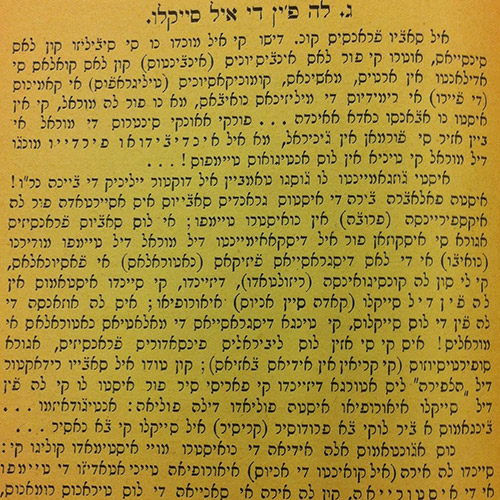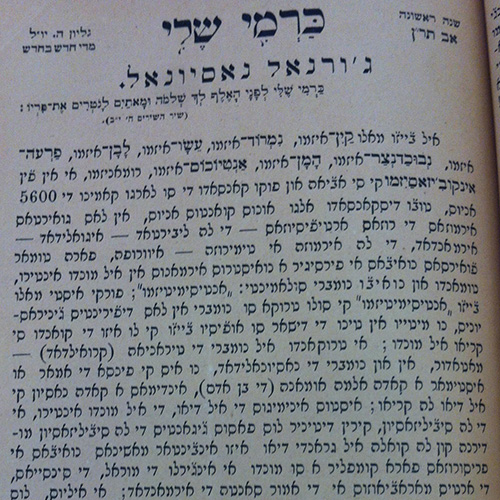Explore Feuilletons
The End of the Century
Item sets
Abstract
Title (English)
Title (original)
Title (transliterated)
Date Issued
Author
Newspaper
Language
Content type
Translator
Contributor
Copyright status
Related Text
Keywords
Original Text
Translation
Barukh Mitrani, “The End of the Century,” 1891. Translated by Tamir Karkason
The French scholar Con.1 claimed that the world did not become civilized owing to the sciences. On the contrary, the inventions – with all the advancement they have brought in arts, machines, communication means (telegraphs) and routes (of the railroad track),2 and cures for new diseases – did not [bring advancement] to morals, regarding which nothing has advanced at all... For, while generally centers of moral have come into being, the individual has lost much of the moral he had in ancient times!
Doctor Jellinek3 of Vienna also expressed this opinion. This word of truth of the great scholars is ascertained by the experience of our time; and the French scholars are now apologetic for the decline of morals in our modern period and for the physical and spiritual miseries that it led to, claiming that these miseries are the result of us being at the end of the century in Europe; it is the habit of the end of the centuries to bring with them the misery of natural and moral illness! Now the liberal French thinkers are making themselves out to be superstitious (who believe in empty ideas).
Yet, the wise editor of HaTzefirah4 confessed that it seems to him that existing in Europe at the end of the century is like rolling a wheel (polea): [a wheel called] Anti-Judaism (antidjudaismo). We will see what the new century that is about to be born will produce...
To this idea of our very esteemed colleague [Sokolow], we would like to add the following: Since the European era is related, in time and in history, to the rage and fury of the Roman tyrants, who, alas, destroyed our temple and dispersed our nation, we have a reason to hope that the end of this European century – one that began and continued with cruel Anti-Judaism – may improve our situation in the European world, since we have heard how very important governments and peoples such as the English, the Americans, the Italians, and some Dutch and Germans, rise against the tyrannical Anti-Judaism! [...]
- Probably Nicolas de Condorcet (1743–1794), a French philosopher and mathematician. ↩
- Literally: “of the iron” (de fierro). ↩
- Adolf Jellinek (1821–1893) was an Austrian-Hungarian rabbi and Wissenschaft scholar. ↩
- HaTzefirah (Warsaw and Berlin, 1862–1931) was a Hebrew newspaper that promoted various shades of Haskalah, modernism, and from the 1880s onward – also Jewish nationalism. From the mid-1880s, the editor-in-chief of HaTzefirah was Nahum Sokolow (1859–1936), a well-known Zionist leader, author, and translator. ↩
Commentary
Barukh Mitrani, “[On Antisemitism],” 1890, and “The End of the Century,” 1891. Commentary by Tamir Karkason
These two feuilletons were written in Ladino by the Ottoman maskil Barukh Mitrani (1847–1919), who lived at the time in Edirne, in the northwest of what is now Turkey, in his periodical Karmi sheli (My Orchard, Pressburg and Vienna, 1890–1891).
Just as synagogue sermons create connections between the Jewish sources and current events, newspapers also address contemporary developments in constantly changing ways. Thus the emergence of the Jewish press in the nineteenth century soon led to a realization of the similarities between the medium of the sermon and the medium of newspapers, especially in the new form of the feuilleton. Mitrani, who was born in Kırk Kilise in eastern Thrace (today Kırklareli, Turkey), and wandered between Southeastern Europe, Istanbul, and Palestine, was the maskil who most clearly demonstrated the connection between the sermon and the press in the Ladino cultural sphere.
Read Full
Between the 1860s and the 1890s, Mitrani published a wide range of material in Ladino and Hebrew, including hundreds of articles in Hebrew-language newspapers based in Europe and Palestine. From the 1880s he founded several Ladino or bilingual (Hebrew and Ladino) publications in which sermons played a central role.
Mitrani preached in synagogues on an occasional basis. While settling in Sofia (now in Bulgaria) he wrote: “And therefore the dear journals […] will be more useful than ten sermons of fatigued preachers. For new matters and articles from a distant land will stir up and awaken much more than the local preacher does in his sayings alone” (“Ivri Anochi,” February 16, 1877). It is not surprising to find that the issues of Mitrani’s first journal, Karmi, in the early 1880s took the form of an ongoing maskilic sermon, and a decade later Mitrani published in his Karmi sheli several articles I have identified as Ladino feuilleton sermons: a hybrid version of the feuilleton which essentially employs a “modern” form of a “traditional” tool to criticize modernity.
As a rabbinic maskil, the medium of the feuilleton sermon allowed Mitrani to express his whole intellectual personality, in which “tradition” and “modernity” were interwoven. In the first text, “On Antisemitism” (1890), he connects the anti-Semites of his own days with biblical and other ancient figures such as Pharaoh, Haman, and Antiochus, and used the suffix “-ism” (-izmo in Ladino) to identify them. The historical “hatred of Israel” and the so-called modern “antisemitism” were entangled in Mitrani’s thought. Ironically, the form of the feuilleton, which was increasingly perceived as a Jewish form by antisemitic writers, served Mitrani to discuss the phenomenon of antisemitism.
In both texts, and specifically in the second text, “The End of the Century” (1891), Mitrani claims that moral standards were failing to keep pace with technological developments, and does not hesitate to quote French intellectual such as Nicolas de Condorcet, as well as two European Jewish intellectuals, Adolf Jellinek and Nahum Sokolow, “the wise editor of HaTzefirah.” However, he criticizes the modern age as one in which antisemitism had found its place “in the fine gardens of the artificial roses of liberty, equality, and fraternity in beautiful and mighty Europe.”
Barukh Mitrani combined his rabbinic background and Jewish observance with an openness to Ottoman and Western modernity. He was therefore a prototypical figure of the Ottoman maskil, who differed from “Westernizers,” supporters of the Alliance israélite universelle who were dominant in the popular Ladino press, on the one hand, and from some Ultra-Orthodox circles that sought to withdraw from teaching “secular” studies such as science and foreign languages, on the other (Karkason 2021). In his Sephardi identity and residence on the margins of Europe and Asia, Mitrani also differed from most Hebrew writers and readers of the time. Although he perceived himself as an integral part of modern Hebrew culture, he also felt that Central and Eastern European Jewish intellectuals excluded him and his Ottoman peers. In light of the unique story of this wandering maskil, who sought a bridge between East and West in the nineteenth century Jewish diaspora, it is no wonder that Mitrani’s texts are emblematic of the hybrid medium of Ladino feuilleton sermons.
Further Reading:
- Aron Rodrigue, “Jewish Enlightenment and Nationalism in the Ottoman Balkans: Barukh Mitrani in Edirne in the Second Half of the Nineteenth Century Minorities in the Ottoman Empire,” in Minorities in the Ottoman Empire, ed. Molly Greene (Princeton: Markus Wiener Publishers, 2005) 129–143.
- Michael Studemund-Halévy, “Ivri, Daber Ivrit! Baruch Mitrani, a Turkish Sefardic Maskil in Vienna,” Transversal 13, no. 2 (2012): 9–39.
- Tamir Karkason, “Between Two Poles: Barukh Mitrani between Moderate Haskalah and Jewish Nationalism,” Zutot 18 (2021): 1–11.


